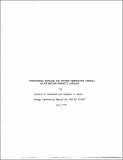| dc.description.abstract | A short-term temperature forecasting (STF) system is proposed to
predict and control plant intake and discharge temperatures at Salem
Harbor Electric Generating Station. It is desired to minimize receiving-water (i.e., intake-water) temperatures during peak power
demand periods, in order to minimize the cost of complying with the
maximum discharge water temperature limit. This study addresses
the hydrothermal modeling requirements of an STF system.
An important element of an STF system is a predictive model of
plant intake water temperatures. For application to Salem Harbor
Station, strict model performance criteria exist, defining a model
development problem: Develop a simple model to predict plant intake
water temperatures 24 hours ahead, predicting daily peak intake temperatures within 10F on 90% of the days, and using only existing
measurements. An estimation-theoretic approach to model development is
used, which quantifies and minimizes the uncertainties in the model.
The approach employs optimal filtering and full-information maximum-
likelihood (FIML) estimation to obtain optimum parameter estimates.
A two-basin, two-layer hydrothermal model of Salem Harbor is developed.
The model computes hourly intake temperatures, incorporating tidal
flushing, stratification, surface heat exchange, and wind advection of
the plume. Twenty-eight model parameters and five noise statistics
are estimated from intake-temperature data.
Preliminary best-fit parameter values are obtained subjectively,
followed by FIML parameter estimation using a data base of 96 hourly
measurements (7/29 - 8/2/74). The model is tested for 106 days (5/17-
9/20/74) and various performance measures are computed, including sum-
of-squares of measurement residuals (S), whiteness (P), percent of daily
peak temperature predictions within 10F of actual (T), and others.
Visual inspection of 24-hour intake temperature predictions shows that
the two-basin, two-layer model performs qualitatively well. However,
the model fails statistical tests on S and P, indicating structural
weaknesses. FIML estimation yields physically unrealistic values for
certain parameters, probably compensating for inadequate model structure. Despite structural flaws in the two-basin, two-layer model, FIML
estimation yields parameters with consistently better performance than
the preliminary estimates (by a small amount). It is concluded that the two-basin, two-layer model is presently
unsuitable for STF use, largely due to structural weaknesses. Possible corrections are suggested; however, a statistical model of
hourly temperatures appears to offer greater potential accuracy than
physically-derived models. FIML parameter estimation is shown to be
useful for water quality model development on a real system, particularly
after subjective model development has been exhausted. | en |
